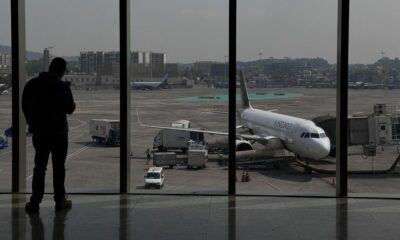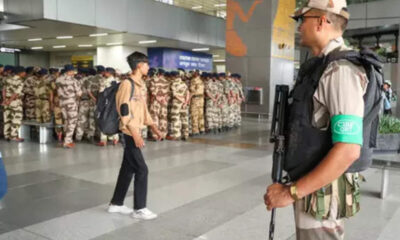Destination
Regional airports found wind beneath their wings in FY24, BA News, BA

Air travel in India’s hinterland recorded a surge last fiscal, according to data from the civil aviation ministry, driven by government schemes and expansion of services into unserved and underserved areas by some airlines.
At the country’s regional airports, the number of air travellers jumped between 30 per cent and 702 per cent in FY24 from the previous year.
The airport in Diu, operational since 2018, saw passenger traffic increase by 65 per cent to 66,252. Flights operated by IndiGo to Ahmedabad and Surat from Diu had an average passenger load factor (PLF), or passenger carrying capacity, of 69 per cent, according to the ministry’s data, which ET has reviewed.
Pantnagar airport, which opened in 2019, saw a 55.8 per cent rise in passenger count to 110,824. Shillong wasn’t far behind, seeing an over 40 per cent rise in air traveller numbers from FY23 on the back of some of the lowest fares in the Northeast. Data from online travel aggregator ixigo showed that air fares for Guwahati and Dimapur start at just INR 400.
Agra, too, saw strong growth, with a 40.9 per cent rise in passenger traffic to 182,956 in FY24. Among regional airports, Tezpur stood out for a 702 per cent increase in passenger traffic — from around 4,000 passengers in FY23 to over 32,000 in FY24. Although the base is low, affordable fares from Tezpur to Lilabari — as low as INR 150, as per ixigo — are likely to have contributed to its popularity, said experts. The ministry’s data also shows a healthy 68 per cent PLF for flights from Tezpur, indicating strong demand on these routes.
India’s aviation sector is undergoing a significant shift towards increased regional connectivity. This growth, driven by government initiatives, airline expansion, and rising passenger demand, is opening up new opportunities for smaller cities and towns, said experts.
To be sure, some airports have not seen the same explosive rise. Prayagraj (formerly Allahabad), Belgaum, Durgapur, Hubli, and Dimapur saw single-digit percentage increases. However, these airports still handle a significant number of passengers, with annual figures between 300,000 and 600,000, the data showed.
Jagannarayan Padmanabhan, senior director at research and ratings agency Crisil, said, “Network expansion by a few airlines and a focused approach of developing regional connectivity and integrating it with metro airports has helped these airports in garnering good traffic growth.”
Data from online travel agency Cleartrip shows that places like Darbhanga, Durgapur, Prayagraj, Gwalior, Kannur, Dimapur, Kanpur, Shillong, Salem, and Belgaum were the most popular regional destinations in online searches. “This highlights the growing demand for air travel connections in smaller cities,” said an analyst.
This surge in regional air travel coincides with Indian airlines actively expanding operations to these airports.
Earlier this year, IndiGo CEO Pieter Elbers said 87 per cent of India’s population lives within 100 km of the airports where the airline operates flights, adding that IndiGo is committed to expand its network.
At a recent IndiGo earnings call, chief financial officer Gaurav Negi said that while the number of routes under the Udan scheme has reduced, the airline continues to operate on them. IndiGo classifies these routes in its ATR fleet as those are the ones it largely focuses on from a regional standpoint.
In terms of contribution to overall revenue, Negi said regional routes’ share is “around the low single digits to mid-single digits”, but they are an “important component from a feeder traffic standpoint”. He added that the regional segment is an “important element” of the low-cost carrier’s strategy which feeds into its larger networks of the A320 and the A321s (which operate majorly on metro routes) on the domestic and international segments.
The aviation ministry data also showcased promising examples, like the Bangalore-Salem route operated by IndiGo. It boasts of a 71 per cent PLF with average airfares as low as INR 840, demonstrating the potential for affordability and high passenger demand on regional routes.
Earlier this week, the carrier announced direct flights to Vijaywada, its third regional destination this month.
IndiGo is also believed to be in talks with aircraft manufacturers to acquire at least 100 smaller planes, specifically for its regional network, ET had reported in May. Air India is also said to be focusing on expanding its regional connectivity. Regional airlines like StarAir and Fly91, too, have been rapidly expanding their network to connect smaller cities. According to industry experts, this means Indian carriers are tapping the potential of the regional segment.
-

 Destination8 months ago
Destination8 months agoSingapore Airlines CEO set to join board of Air India, BA News, BA
-

 Breaking News10 months ago
Breaking News10 months agoCroatia to reintroduce compulsory military draft as regional tensions soar
-

 Gadgets3 months ago
Gadgets3 months agoSupernatural Season 16 Revival News, Cast, Plot and Release Date
-

 Tech News12 months ago
Tech News12 months agoBangladeshi police agents accused of selling citizens’ personal information on Telegram
-

 Productivity11 months ago
Productivity11 months agoHow Your Contact Center Can Become A Customer Engagement Center
-

 Gadgets3 weeks ago
Gadgets3 weeks agoFallout Season 2 Potential Release Date, Cast, Plot and News
-

 Breaking News10 months ago
Breaking News10 months agoBangladesh crisis: Refaat Ahmed sworn in as Bangladesh’s new chief justice
-

 Toys12 months ago
Toys12 months ago15 of the Best Trike & Tricycles Mums Recommend




















